Jim Finley is a bit of a ghost. Outside of oil industry circles, few people have probably ever heard of the man. He rarely speaks in public.
One exception was in October 2021, when Finley, the CEO of Texas-based Finley Resources, presented to a coalition of seven oil-producing counties in eastern Utah. Following his speech, coalition board members and staff applauded Finley for his investments in Utah’s oil-rich Uinta Basin, and thanked him for making time to speak. One person noted that he is a particularly difficult man to get hold of.
“Sometimes nobody knows where I am,” Finley said.
“On purpose,” someone else chimed in. Finley chuckled.
The Texas oilman has played a key role in spearheading the kind of oil boom that has long evaded the remote basin. In just over a decade, he’s become one of the top producers in the Uinta and is now playing an outsize role in shaping Utah’s energy future.
Finley has thrown his support behind a controversial rail line that would make it easier for him and the basin’s five other producers to export oil to out-of-state markets, while simultaneously boosting export capacity via trucking and existing rail. He has his fingers in every aspect of basin production, from drilling oil and mining sand for hydraulic fracturing to operating a transloading facility and a growing fleet of oil trains. Powerful political allies have helped him expand his empire, primarily by funneling public money toward infrastructure projects that benefit the oil sector.
Chris Kuveke, a researcher at BailoutWatch, a watchdog group that provided HuffPost with extensive research on Finley’s portfolio and operations, called Finley “the mastermind” of the basin’s current oil boom.
“He has a long history of using campaign finance and lobbying as influence to get his projects where he wants them to be,” Kuveke said. “He knows what he’s doing. He has a serious track record of influencing the industry that he wants to grow, being a linchpin. And that’s what he’s doing in the Uinta.”
Finley and other producers’ long-term vision for the Uinta could lead to as much as 350,000 barrels of crude oil being railed from Utah to Gulf Coast refineries every day, roughly tripling current basin production and increasing U.S. annual carbon emissions by 1%.
Oil and gas industry players and longtime observers, including two who requested anonymity to speak plainly about the Uinta’s trajectory, credited Finley for the basin’s recent growth.
“He kind of broke the seal,” a current industry official told HuffPost, adding that other basin producers have followed Finley’s lead in shipping oil out of state.
A retired industry professional called Finley the “puppetmaster” of Utah energy policy, and admitted to having “a degree of rueful admiration” for how he’s secured public funds for his ventures.
“It is a classic story of using ‘other people’s money’ — in this case, that of Utah taxpayers — while leaving them stuck with the environmental and public health bill,” the retired professional told HuffPost.
Finley did not respond to HuffPost’s multiple requests for comment. Nor did Brent Talbot, the president of Finley Resources, or other company representatives ― continuing a pattern they’ve demonstrated with other news outlets. If not for a presentation Jim Finley gave at a tax conference in Utah in 2022, and a press release announcing his company partnering with Uintah Basin Technical College, HuffPost likely wouldn’t know what he looks like.
“He’s very much behind the scenes,” Kuveke said. “I think he recognizes that he can get a lot more done with his capital, and he can protect his reputation.”
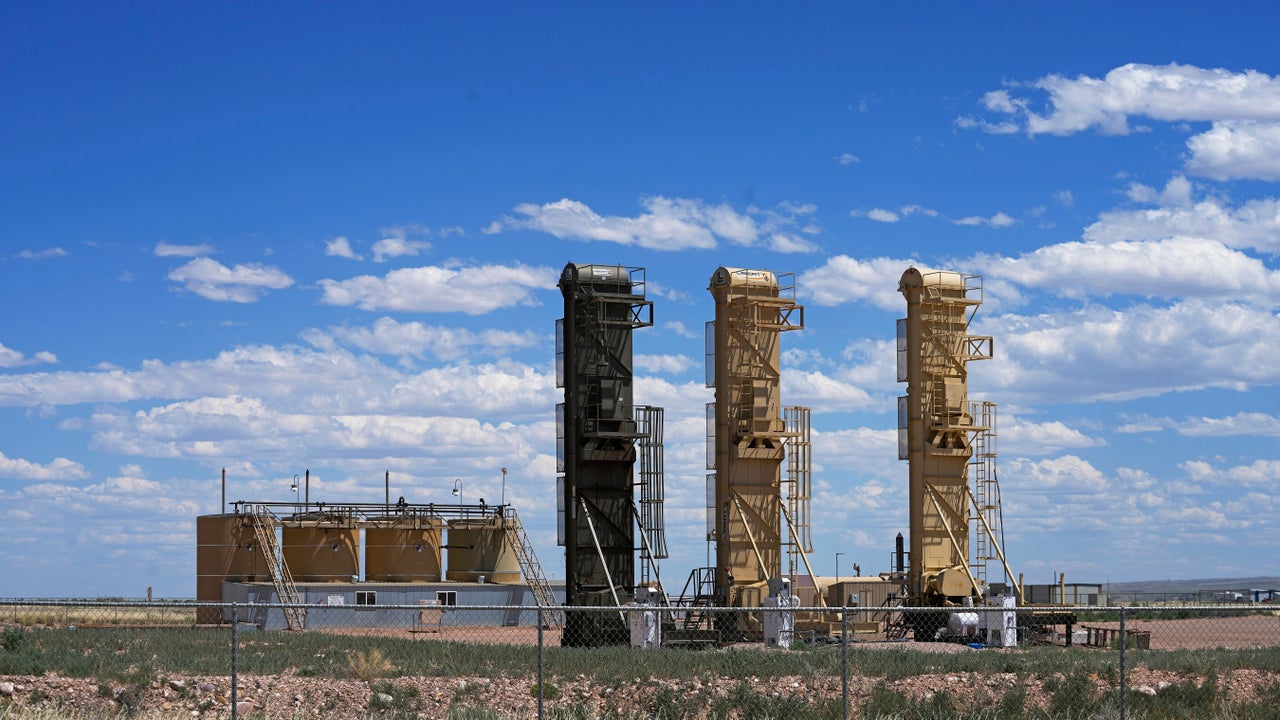
‘The best oil we’ve ever seen’
In July 2022, Talbot held court over a meeting of Uinta oil and gas drillers. He was there, he said, to deliver a message from his boss: The company’s success in the basin would “lift all ships.”
“You guys are sitting on a jewel of a resource. It’s something that Jim Finley has been trying to tell people for seven or eight years, and finally it’s coming to fruition,” Talbot said. “What drives him is not the financial gain. What drives him is to see this basin grow. He wants everyone to be successful.”
The basin’s “waxy” crude is indeed unique — low in sulfur, acids and metals — and demand is growing for its use in lubricants, makeup products, building materials and other non-combustion products. Talbot called it a “world-class resource,” as “pure” a hydrocarbon as they come.
Finley first arrived in the Uinta in 2008 after his company acquired several leases from El Paso Gas Company. In that meeting, Talbot recalled his and Finley’s first visit to the site on a snowy, subzero day in February of that year.
“I just thought to myself, ‘Jim, there’s plenty of oil in warm places. What are we doing here?’” Talbot said. “That changed quickly.”
What they found were massive hydrocarbon reserves in deep layers known as stacked pays — “formations that were very productive, just waiting for somebody to exploit them,” Talbot said.
Drilling in the basin began to surge over the next several years. However, production hit a roadblock around 2013, when the five small refineries in Salt Lake City reached their 85,000 barrel-per-day capacity. That’s when Finley and his allies got serious about finding ways to “break the export barrier,” as Finley has put it.
But Uinta’s waxy crude comes with major transportation hurdles. Below 110 degrees, the oil is a sticky semi-solid, meaning it must be heated to transport via train or truck, at added cost. Those challenges meant local refineries would only accept it at a discounted rate.
It was around that time that Finley Resources hired an industry consultant — Talbot didn’t say which one — to study the wax and find potential buyers. “For years, the refineries just told us, ‘Man, this is bad stuff ... You need to discount it,’” Talbot said. “What these consultants told us is, ‘This is the best oil we’ve ever seen.’”
“We are no longer the black sheep of the oil industry,” he added with a chuckle. “Refineries all over the country desire this wax.”
It appears Finley would prefer to ship this waxy crude entirely by rail. He has voiced support for the Uinta Basin Railway, a $3 billion, 88-mile proposed rail line that would connect the remote basin to the national railway system.
The project’s backers see the railway as essential for long-term production growth — and have pushed millions in project costs onto taxpayers. Opponents see it as a “carbon bomb” that threatens U.S. climate goals, scarce water resources and public health.
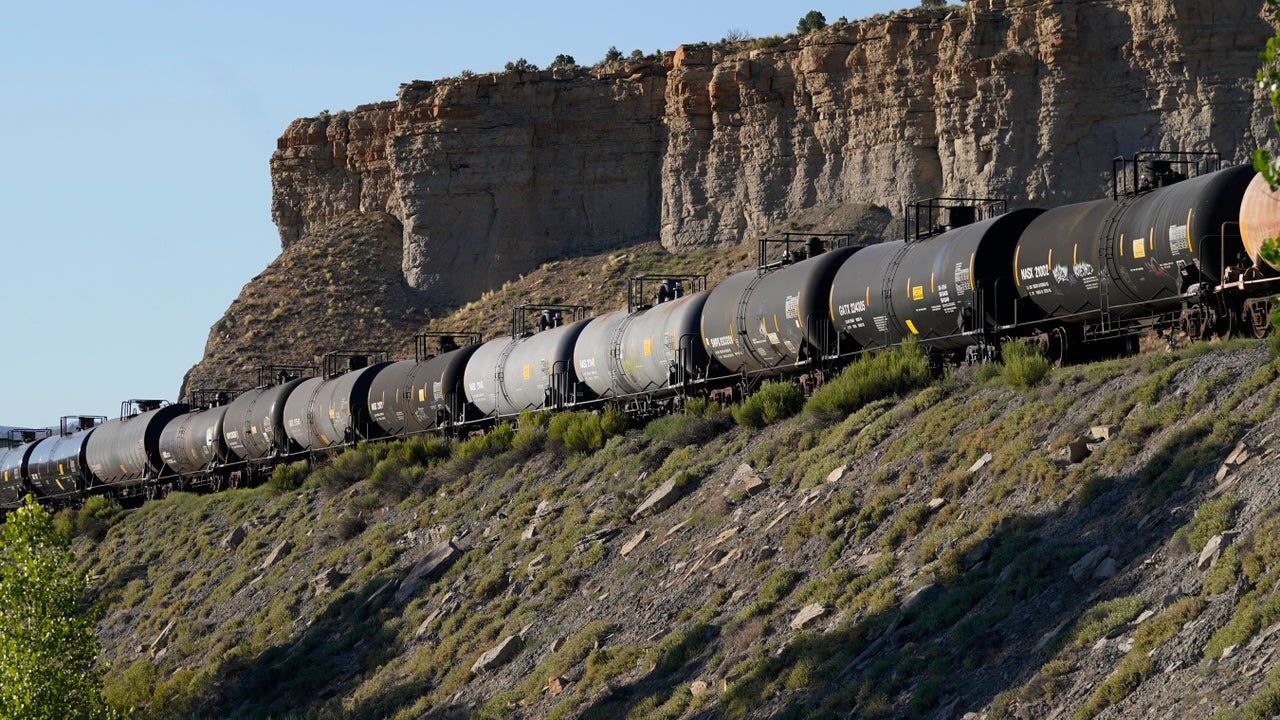
The controversial project hit a major snag in August when a U.S. appeals court vacated federal regulators’ approval of a key permit, ruling that the Surface Transportation Board failed to properly consider climate and other environmental risks. The court has since rejected a motion from railway supporters to rehear the case, effectively sending the project back to square one. Further jeopardizing the project’s future, the U.S. Forest Service has officially withdrawn its approval of a right of way for the railroad to traverse a 12-mile section of the Ashley National Forest.
But Finley isn’t one to put all his eggs in one basket. He’s been diligently working to expand trucking and existing rail to get more Uinta crude to large out-of-state refineries, where profit margins are higher.
“Jim is a very respected voice in the oil and gas community in the Uinta basin,” said Thomas Holst, a senior energy analyst at the University of Utah who for decades worked for oil giants Chevron and Mobil Oil. “He’s not necessarily counting on the rail. The rail would be good, but in the meantime there are other ways to get crude oil from the Uinta Basin to where it can transload on trains that go to the U.S. Gulf Coast.”
Environmental groups warn that that effort, much like the proposed Uinta Basin Railway, comes with myriad environmental and public health risks, as it would mean significantly more tanker trucks traversing mountain terrain, as well as oil trains running between Utah and the Gulf Coast.
Last year, Utah crude oil production reached a record high of 52 million barrels — more than 140,000 barrels per day — and Uinta Basin production is forecast to reach as high as 175,000 barrels per day in the second half of 2024, according to a recent economic report from the Utah Geological Survey. Approximately 85% of Utah’s oil and gas is extracted from the Uinta.
‘Spaghetti at the wall’
Finley has grown his footprint exponentially since he first arrived in the Beehive State. His two drilling companies, Finley Resources and Uinta Wax Operating LLC (also known as CH4-Finley Operating, LLC), operate across a combined 340,000 acres in the basin, much of it federal land, and are producing approximately 26,000 barrels per day, according to state data. (Only one Uinta operator, XCL Resources, produced more last year.)
At current crude oil prices of around $75 per barrel, that amounts to more than $700 million in pre-tax revenue annually. Finley has said the Uinta has the “best producing rock in all of the United States,” and that the rate of return means his companies are able to keep oil rigs running down to roughly $45 per barrel.
Among Finley’s most strategic moves was purchasing a 50% stake in the Wildcat Loadout Facility near Price, Utah — an acquisition that Talbot called the “most important story in the basin.”
Located on federal land and originally used for shipping coal, the facility is now transferring more than 20,000 barrels of Uinta waxy crude, hauled out of the basin in tanker trucks, onto rail cars bound for Gulf Coast refineries, including ExxonMobil’s facility in Baton Rouge, Louisiana — in the heart of the heavily polluted industrial hub widely referred to as “Cancer Alley” — and the Saudi Arabia-owned Motiva refinery in Port Arthur, Texas.
To keep the oil flowing south, Finley Resources is looking to dramatically expand the loadout facility’s capacity from 30,000 barrels to 100,000 barrels daily. Colorado Newsline reported in November that the facility has been out of compliance with state pollution rules for the last several years. The president of Wildcat Loadout Management declined to comment on the noncompliance, other than to tell a Colorado Newsline reporter, “You guys need to figure out where you get your information from.” (For the record, the publication got its information directly from state regulators.)
If the Bureau of Land Management approves the proposal, the expansion would lead to a dramatic increase in both hazardous truck traffic out of the basin and oil trains running between Utah and the Gulf Coast, including along a 100-mile stretch of the Colorado River and its headwaters. BLM’s website currently notes that the project has been “paused,” and an agency official told HuffPost that BLM has an “incomplete” understanding of the proposal and that “no one at BLM is actively working on the project at this time.”
Two other area rail loadout facilities, the Price River Terminal and the Savage Energy Terminal, are also eyeing expansions. If all three receive final approval, oil export capacity would soar from a combined 110,000 barrels per day to 260,000 barrels per day, according to a fact sheet that the Center for Biological Diversity and the Southern Utah Wilderness Alliance developed. That could lead to more than 900 oil tanker truck trips out of the basin every day, or one approximately every one and a half minutes, they found.
Environmentalists fear that either route, the Uinta Basin Railway or expanded trucking and transloading, is a disaster waiting to happen — for the global climate, scarce water resources, wildlife, local communities and sensitive archeological sites.
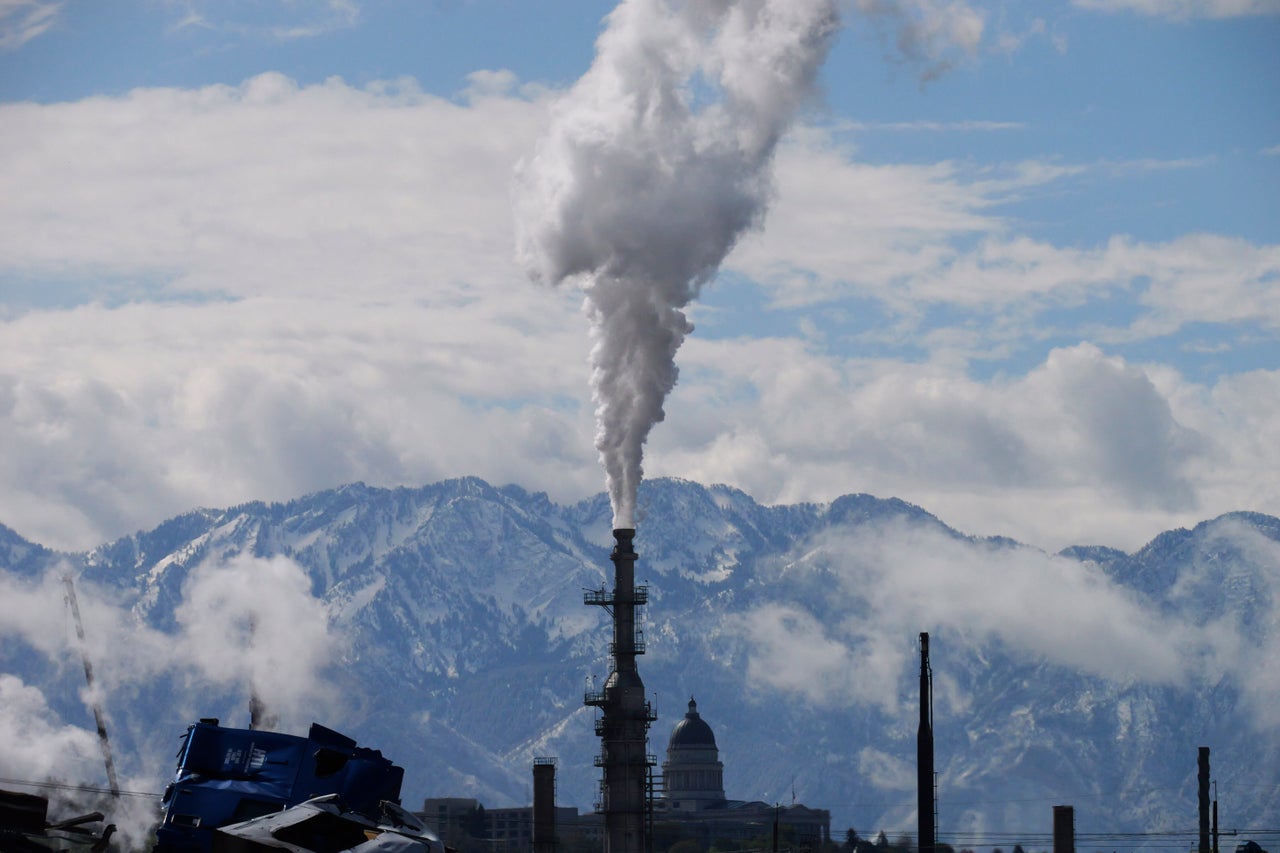
Landon Newell, a staff attorney for the Southern Utah Wilderness Alliance, said Finley and other Uinta producers have “taken a throw-spaghetti-at-the-wall approach” to massively expand drilling and open up new out-of-state markets. If successful, their plans would deliver a “double whammy” to the environment and area communities, he said.
“You get huge public health impacts and the oil is all leaving the state,” Newell said. “Certainly there are jobs, certainly there is revenue — royalties and so on — but a lot of the ‘benefit’ for oil extraction goes elsewhere, and the vast majority of the negatives — health, pollution, so on — are left in the basin.”
The Uinta Basin is already plagued with periodic bouts of poor air quality. The fossil fuel industry is the largest local source of ozone-forming pollutants.
Seth Lyman, an air quality and energy industry expert at Utah State University, said that while Utah’s oil and gas sector has gotten better at controlling emissions, there is “good reason to be concerned that pollutant emissions and our air pollution problem would increase in an increased oil and gas production scenario.”
“How much it would increase, and what the health effects would be, are outside of what we know right now,” he added. “There is not yet oil and gas production in the United States that doesn’t lead to significant air pollution impacts.”
In 2022, the Environmental Protection Agency reached a $3 million settlement with Crescent Point Energy U.S. Corp. over alleged Clean Air Act violations at its facilities in the Uinta. The agreement came more than two years after Finley Resources and CH4 Energy Six purchased Crescent Point’s assets in the Uinta for $525 million.
Utah leaders have largely embraced Finley’s vision for the basin, citing the economic benefits, while those in neighboring Colorado and environmental groups have fought it at every turn, in part due to the risk of an oil spill into the Colorado River, the main water source for approximately 40 million people.
A Surface Transportation Board analysis found that the increased rail traffic from the Uinta Basin Railway — approximately five trains per day, each of them two miles long — could lead to a train accident about once a year along existing track between Denver and Kyune, Utah, with 25% of those resulting in an oil spill. The executive director for the Seven County Infrastructure Coalition dismissed that risk as “low.”
“I’ve sounded the alarm on the dangers of the Uinta Basin Railway,” Sen. Michael Bennet (D-Colo.) wrote in a post on X, formerly Twitter, in November. “Now, the proposed Wildcat Loadout expansion poses similar threats to the Colorado River & local communities. This project would be disastrous for our state.”
Heavy handouts
In their race to exploit the Uinta, drilling companies, fossil fuel-producing counties and Utah elected officials have worked — successfully in some cases — to push costs onto the public.
The Seven County Infrastructure Coalition, an interlocal agency formed in 2014 that comprises seven mineral-rich counties in eastern Utah, has spearheaded the Uinta Basin Railway, as well as several other oil and gas projects in the region. It secured Drexel Hamilton Infrastructure Partners, or DHIP Group, to finance the rail project, and Rio Grand Pacific Corporation to design and operate it.
In 2018, the coalition applied for a $30 million grant from Utah’s Permanent Community Impact Fund Board to pay for the design, permitting and legal costs of the project. It was a bold request, given that the fund was set up to distribute royalties from resource extraction on federal lands to pay for improvement projects in communities most heavily affected by drilling and mining ― not to advance more fossil fuel projects.
In 2019, despite concerns from the Utah attorney general’s office and other state officials about the legality of using fund dollars for an oil train project, the board awarded $28 million to the Seven County Infrastructure Coalition. The following year, a state audit identified numerous projects, including the Uinta Basin Railway, that it said “raise concerns surrounding how mineral lease funds are used,” and recommended the program be overhauled to ensure money is being directed to projects that mitigate the effects of mineral extraction, rather than boosting private-sector interests. (A separate report from environmental groups in 2021 found that the board had distributed more than $109 million to projects that boosted fossil fuels.)

Republican state Sen. Ron Winterton, who represents much of the Uinta Basin and is a fierce supporter of the rail project, found a different fix. In early 2021, he introduced a bill to amend the state statute governing the use of mineral lease funds, stripping language that required the funds to be used “for the alleviation of social, economic and public finance impacts resulting from the development of natural resources in this state.” Critics saw it as little more than a giveaway to fossil fuel interests, but the legislature passed the bill.
Few if any Utah elected officials have done more to try to assist Finley and other Uinta drillers. Talbot has called Winterton “a great advocate” of Finley Resources’ projects.
Winterton was a member of the Permanent Community Impact Fund Board when it awarded the first $6 million to the Seven County Infrastructure Coalition to design the oil railway, Mother Jones reported. At the time, he was also a consultant for Jones and DeMille Engineering, the very firm that the coalition hired to oversee project management.
In 2019, Winterton sponsored failed legislation that would have eliminated the state’s 7.5% sales tax that oil and gas companies pay for equipment and materials used for extraction, The Salt Lake Tribune reported. During a 2022 appearance at a Utah Taxpayers Association conference, Finley bemoaned that Utah doesn’t provide sales tax relief to his industry.
“Utah ought to be a leader in incentivizing fossil fuels,” he said. “We need to be sending a signal that Utah is a place to spend your money drilling oil and gas wells.”
Winterton did not respond to HuffPost’s requests for comment.
“If this project truly were economically viable, its developers would have no need to rely on federal subsidies.”
- Sens. Michael Bennet (D-Colo.) and John Hickenlooper (D-Colo.), and Rep. Joe Neguse (D-Colo.)
Early last year, before the courts derailed the Uinta Basin Railway, project backers hatched a plan to get taxpayers to cover millions of dollars’ worth of construction costs. In February, the Seven County Infrastructure Coalition passed a resolution giving the railroad a green light to apply for up to $2 billion in low-interest, federally subsidized bonds from the Department of Transportation.
Railroad developers did not officially submit an application prior to the court ruling, but the bond scheme sought to cover 70% of the railroad’s development costs and, according to one tally, would have saved the railroad — but cost taxpayers — an estimated $80 million per year for the life of the bonds.
In a March letter, Bennet joined Sen. John Hickenlooper (D-Colo.) and Rep. Joe Neguse (D-Colo.) in urging Transportation Secretary Pete Buttigieg to deny any future bond request, arguing that it would “irretrievably sink taxpayer dollars into a project that has proven unable to contain its own costs.”
“If this project truly were economically viable, its developers would have no need to rely on federal subsidies,” the lawmakers wrote.
The oil and gas sector remains one of the most heavily subsidized industries in the U.S., despite reporting record profits in recent years. Finley’s companies have been no exception.
Bailout Watch found that Finley’s companies received more than $140 million in COVID-19 relief funds, including a $130 million loan from the Main Street Lending Program, the largest of any oil and gas company, and $11 million from the Paycheck Protection Program. They also benefited hugely from Trump administration-era reductions in royalties, the payments that oil and gas companies make to the federal government to extract oil and gas from federal lands and waters. More than 37,000 federal acres that Finley’s companies lease in Utah and Wyoming were approved for royalty relief early in the pandemic.
Those bailouts appear to have helped Finley continue to grow his Utah operations. His Uinta wells produced approximately 9.4 million barrels of oil in 2022, up from 6.9 million barrels two years prior, according to state data.
Finley is also a major political donor. Bailout Watch tallied over $600,000 in federal and state election spending over the past two decades. At the federal level, most of Finley’s money has gone to Republican candidates and GOP political action committees. In 2022, he gave $5,800 each to Sen. Mike Lee (R-Utah) and the GOP fundraising platform WinRed.
Lee, a fierce supporter of the oil industry, condemned the appeals court’s August decision striking down the Uinta Basin Railway’s approval. He accused the court of being “influenced by ‘woke environmentalism,’” and promised to work with others to “ensure this project moves forward promptly.” A month later, the self-proclaimed champion of the Constitution and the rule of law attempted to reverse the court’s ruling, introducing an amendment to a military appropriations bill that would have rubber-stamped the rail line and stripped all courts of their ability to review federal approvals of the project.
Lee’s amendment ultimately was not included in the spending package adopted in November, but railroad opponents worry similar proposals could turn up in future legislation. Rep. John Curtis (R-Utah) submitted a similar amendment to a 2024 transportation appropriations bill that the House introduced in July. The Utah lawmakers’ efforts mirror those of Sen. Joe Manchin (D-W.Va.), who undertook considerable legislative maneuvering last year to greenlight the Mountain Valley Pipeline.
At a November meeting of the Seven County Infrastructure Coalition, one board member hinted at a possible legislative fix for resurrecting the railway project, but did not elaborate on what that might look like.
Meanwhile, Finley and others are focused on growing Uinta exports without the proposed rail line.
“We’re past the point of non-return,” Finley said at the Utah Taxpayers Association conference in 2022. He noted that if the export market disappeared and rigs had to shut down, it would take two years of decline before Salt Lake City refineries could accept all the oil coming out of the basin.
“We’re shipping a lot of crude out by rail,” he said. “That will continue to grow.”
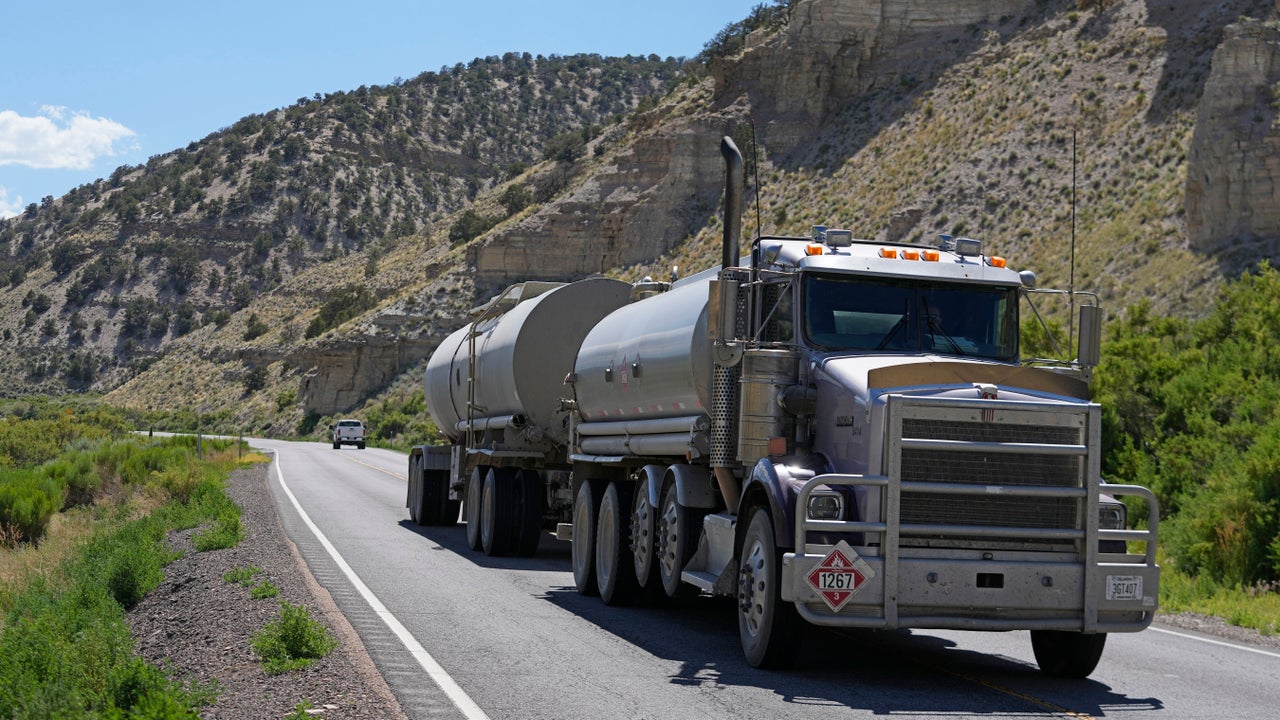
A ‘stepping stone’
Many observers have described the Wildcat Loadout expansion as a backup plan to the Uinta Basin Railway. Deeda Seed, a senior campaigner at the Center for Biological Diversity, see things differently.
“I think it’s always been the plan,” Seed said, referring to trucking. “He has this plan to ramp up production and is working every angle.”
To hear Finley tell it, it is a “stepping stone” to an extraction boom that will eventually demand a rail line.
During his 2021 presentation to the Seven County Infrastructure Coalition, Finley said existing wells in the basin are having “spectacular” success, and projected that in three years, even without the Uinta Basin Railway, he and other Uinta producers would be exporting 100,000 barrels per day to out-of-state refineries.
“At some point the basin is going to hit a brick wall from a truck-traffic standpoint,” he said. “And to grow the basin to 200,000 or 300,000 barrels a day, which it is fully capable of doing, we’ll have to have the railroad.”
Finley went on to explain that his company is unable to back the railroad financially until export volumes are significantly higher.
“It is the classic chicken and the egg,” he said. “We can’t commit volumes so that [DHIP Group] can get funding until we actually have the volume. In order to get the volume, we’ve got to have the truck traffic and the existing rail facilities to get us there. But it’s only a stepping stone to, hopefully, what this basin would look like five or 10 years from now.”
To reach the 100,000-barrel export target, the number of oil tanker trucks traversing a mountainous section of U.S. Highway 191 between the Uinta and rail terminals to the west would roughly triple. The number of train cars hauling oil along the Colorado River and on to the Gulf Coast would also rise drastically, along with the chance of derailments and spills.
Utah lawmakers have funneled tens of millions of dollars in public money toward making that vision a reality. Last session, the Utah legislature approved a request from Winterton, the state senator, for $88 million in funds for road improvements on Highway 191 — investments that Talbot, of Finley Resources, said were key for continued production and export growth.
Separately, Duchesne County has proposed reconstructing and paving a windy, remote road through Gate Canyon, which would give tanker trucks an alternative route out of the basin through Nine Mile Canyon ― a tourist destination with many Indigenous cultural sites that’s known as the “world’s longest art gallery.” The Bureau of Land Management is reviewing the proposal.
“The volume of trucks expected to come down if they succeed in this, on a daily basis, would be a truck every three minutes, which has huge implications for wildlife and the cultural resources in the canyon,” Seed said. “It would basically destroy this area.”
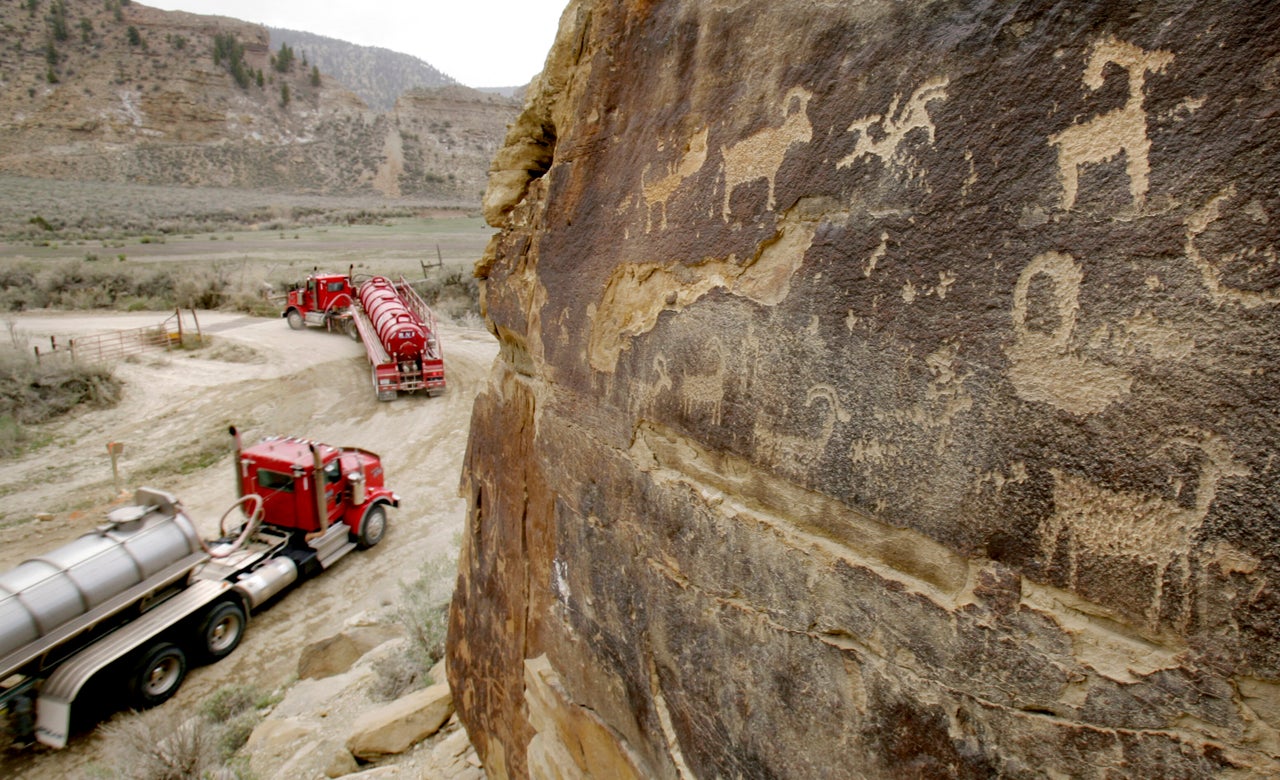
More recently, the Uintah Recreation District requested $27 million in public funds from the Utah Community Impact Board to pay for road improvements around Finley’s new frac sand facility, Wildcat Sand. In its application, which the CIB denied in December, the district noted that the roads “have been heavily damaged by trucks accessing a new frac sand processing facility,” and that the money is needed to upgrade roads “to withstand the truck traffic it is now experiencing and for public safety.”
‘Green’ fuel or greenwashing?
In his quest to grow basin production, Finley has touted Uinta wax as a “green” material that will outlive other hydrocarbons as the nation transitions to renewable energy sources.
“It might be the last fossil fuel produced in the whole world,” he said at the tax conference in 2022.
At the Seven County coalition meeting, Finley said the company has “taken the word ‘crude oil’ out of our vocabulary.”
“We drill for wax. We produce wax. We ship wax on rail, and support the wax railroad,” he said. “So just to let you know, we don’t know much about crude oil anymore.”
Finley highlighted the wax’s use in everything from heat pumps and vehicle thermostats to Carmex lip balm, chewing gum, textiles and bedding. But from what he can infer, it’s the growing wind energy sector, which uses the wax for lubricants in wind turbines, that is driving the surge in demand.
The job of Finley Resources and other Uinta producers is to “show the world that what we produce here in Utah is green,” Finley said. “It’s a good story, and part of what we’ve got to educate everybody on.”
Finley’s attempt to rebrand the material as “industrial wax” is complicated by the fact that the vast majority of what is being produced — approximately 75%, according to Finley — is still being burned for fuel.
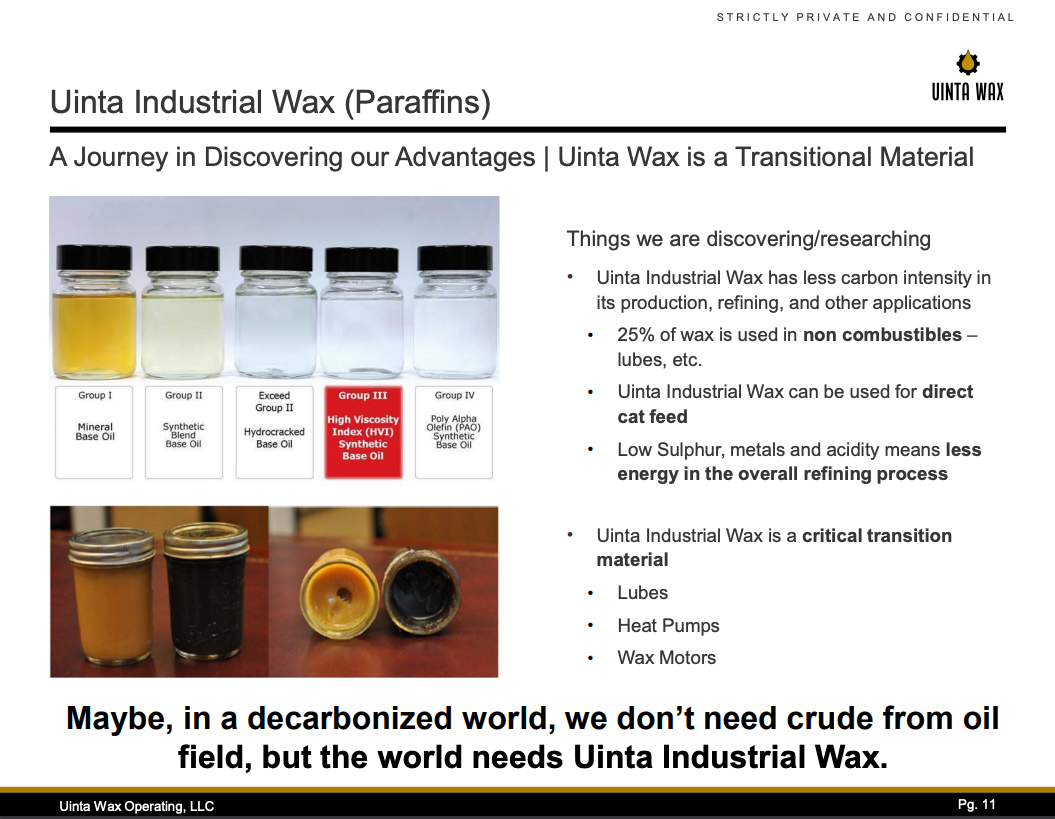
It is also a finite resource. The U.S. Geological Survey estimates there are more than 1.3 trillion barrels of oil in place in the basin, but the waxy crude accounts for only 550 million to 700 million barrels. The rest is dirty tar sands oil and oil shale — resources that are not presently economically viable, but that the industry hopes a railway could eventually help unlock.
Seed pointed out that at the rate the railroad would allow drillers to develop the basin’s waxy crude, the resource could be tapped in as little as five to seven years.
“There’s also the unavoidable fact that producing that much oil out of the Uinta basin every year, conservatively, according to the [environmental impact statement], will release 53 million metric tons of carbon into the atmosphere,” Seed said. “That’s a lot.”
Asked about the timeline for draining the basin of its crude, Holst, the energy analyst, stressed that proven reserves are often inaccurately low.
“I couldn’t answer how long it will last,” he said of the Uinta crude. “But I will say prolific basins — this basin has been producing since the mid-’40s — have a way of perpetuating and defying some expectations.”
Finley and his team are forecasting a multigeneration economic boom that will require an influx of rig workers and truck drivers, as well as new hotels, restaurants and other local business.
“It’s exciting,” Talbot said at the event in 2022. “Everybody in this room and your children, and maybe your grandchildren, should benefit from it.”
The retired industry professional argued that if the state of Utah were thinking strategically, it would develop the basin’s unique resource over time and keep it in the state.
“The path they are on, right now, is to ship all of our good oil out of state. What are we going to replace it with in 20 years?” the retired professional said. “Finley, he’s really doing a major disservice if people would think through it.”
"oil" - Google News
January 31, 2024 at 05:45PM
https://ift.tt/WSxA6bU
Meet The Secretive ‘Mastermind’ Behind Utah's Oil Boom - HuffPost
"oil" - Google News
https://ift.tt/GXEL5VH
Shoes Man Tutorial
Pos News Update
Meme Update
Korean Entertainment News
Japan News Update
Bagikan Berita Ini















0 Response to "Meet The Secretive ‘Mastermind’ Behind Utah's Oil Boom - HuffPost"
Post a Comment